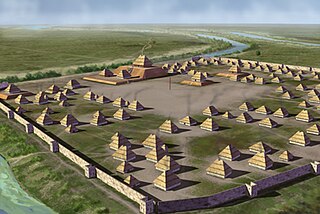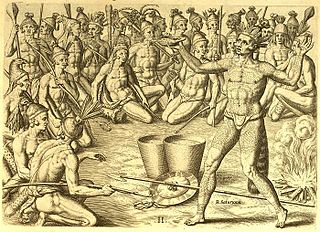 W
WThe Chiefdom of Ameca is the name given to a pre-Columbian state that encompassed the Valley of Ameca in central Jalisco, Mexico. The word Ameca is of Cazcan origin and means "above the water".
 W
WThe Cahokia polity was a political entity that existed with Cahokia as its center and exercising control over outlying areas. Unlike other Mississippian chiefdoms the Cahokia polity had an unusual early emergence, high population, and noted greater regional influence. The majority opinion that a Cahokia chiefdom or a pre-state existed is due to the fact that certain indicators of a state aren't apparent in Cahokia's ruins. Despite Cahokia's large size, certain determining technological and political advance indicating a typical state haven't been found in studies of Cahokia.
 W
WCasqui was a Native American polity visited in 1541 by the Hernando de Soto expedition. This group inhabited fortified villages in eastern Arkansas.
 W
WThe cacicazgos were major chieftainships of the Taíno on the island of Ayiti/Quisqueya spain named it (Hispaniola)]], leading to them being called the Chiefdoms of Hispaniola or the Cacicazgos of Ayiti. These chiefdoms—or cacicazgos, as found and named by the Spanish settlers in the early Columbian era—were governed by Taíno chiefs called "caciques".
 W
WThe Coosa chiefdom was a powerful Native American paramount chiefdom in what are now Gordon and Murray counties in Georgia, in the United States. It was inhabited from about 1400 until about 1600, and dominated several smaller chiefdoms. The total population of Coosa's area of influence, reaching into present-day Tennessee and Alabama, has been estimated at 50,000.
The Jaega were Native Americans living in a chiefdom of the same name, which included the coastal parts of present-day Martin County and Palm Beach County, Florida at the time of initial European contact, and until the 18th century. The area occupied by the Jaega corresponds to the East Okeechobee Area, an archaeological culture that is part of, or closely related to, the Belle Glade culture. The name Jobé, or Jové [ˈxoβe], has been identified as a synonym of Jaega, a sub-group of the Jaega, or a town of the Jaega.
 W
WMocoso was the name of a 16th-century chiefdom located on the east side of Tampa Bay, Florida near the mouth of the Alafia River, of its chief town and of its chief. Mocoso was also the name of a 17th-century village in the province of Acuera, a branch of the Timucua. The people of both villages are believed to have been speakers of the Timucua language.
 W
WOcute, later known as Altamaha or La Tama and sometimes known conventionally as the Oconee province, was a Native American paramount chiefdom in the Piedmont region of the U.S. state of Georgia in the 16th and 17th centuries. Centered in the Oconee River valley, the main chiefdom of Ocute held sway over the nearby chiefdoms of Altamaha, Cofaqui, and possibly others.
 W
WThe Saturiwa were a Timucua chiefdom centered on the mouth of the St. Johns River in what is now Jacksonville, Florida. They were the largest and best attested chiefdom of the Timucua subgroup known as the Mocama, who spoke the Mocama dialect of Timucuan and lived in the coastal areas of present-day northern Florida and southeastern Georgia. They were a prominent political force in the early days of European settlement in Florida, forging friendly relations with the French Huguenot settlers at Fort Caroline in 1564 and later becoming heavily involved in the Spanish mission system.
 W
WUzita (Uçita) was the name of a 16th-century native chiefdom, its chief town and its chiefs. Part of the Safety Harbor culture, it was located in present-day Florida on the south side of Tampa Bay.